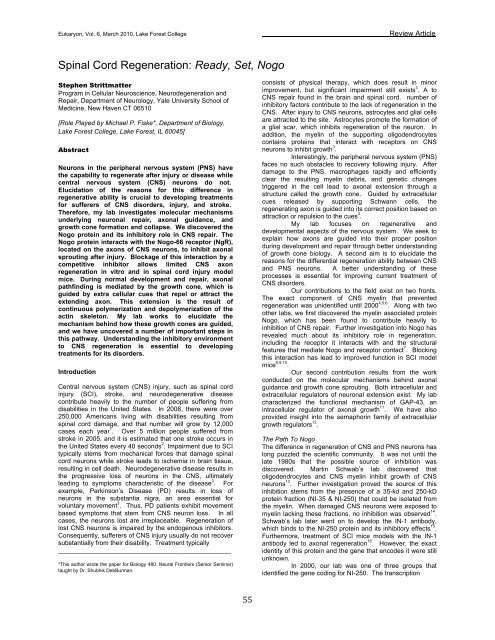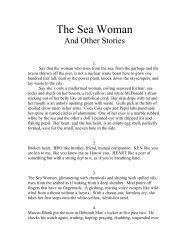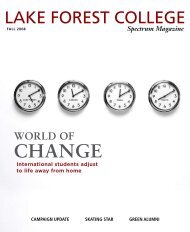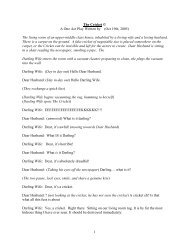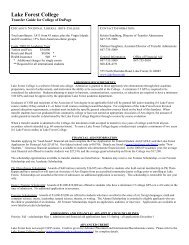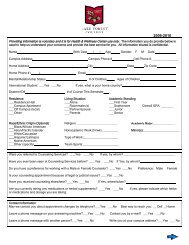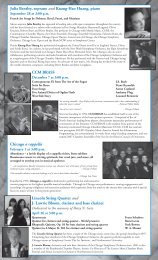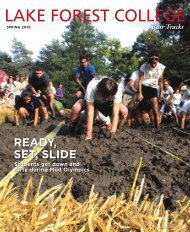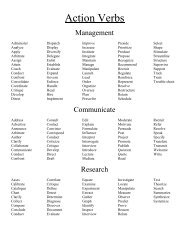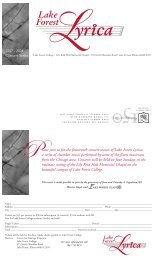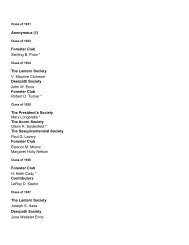Spinal Cord Regeneration: Ready, Set, Nogo - Lake Forest College ...
Spinal Cord Regeneration: Ready, Set, Nogo - Lake Forest College ...
Spinal Cord Regeneration: Ready, Set, Nogo - Lake Forest College ...
Create successful ePaper yourself
Turn your PDF publications into a flip-book with our unique Google optimized e-Paper software.
Intracellular and Extracellular Regulators of Growth ConeStructureIn the PNS, no myeline associated proteins exist that inhibitgrowth cone formation after axonal trauma as in the CNS.Indeed, evidence has accumulated over the past 15 yearsthat supports the presence of both intracellular andextracellular regulators of growth cone formation andguidance. One such intracellular factor is the protein GAP-43 29 . This protein is found to be highly concentrated in themembrane of extending growth cones, but the structuralbasis for this localization during development and injury wasunknown. My lab identified the membrane targeting signallocated on the N-terminal region of the protein 30 . Thefunction of GAP-43 also remained to be revealed. Wedetermined that the GAP-43 protein increases GTP bindingto Go, a G-signaling protein that is found localized with GAP-43 on extending axons 31 . GAP-43 regulation of Go was ahypothesized mechanism of how GAP-43 controls neuronalplasticity. G protein signaling is one known mechanism forchanges in axonal growth 31 . To test this, we injected GAP-43 into oocytes of Xenopus laevis to determine its effect onG signaling. We found that, upon injection, oocytes becameup to 100 times more sensitive to G protein agonists 11 .Thus, it appears that GAP-43 modulates neuronal extensionby increasing the sensitivity of G proteins to cellularsignaling. In crude terms, it acts as an amplifier of thesesignals, sensitizing the cell to the cues for growth conestructural change.The regulation of GAP-43 is controlled by twopost-translation modifications: palmitoylation andphosphorylation 32 . Using GAP-43 mutants lacking regionscritical for the protein’s amplification effect, we determinedthat palmitoylation of GAP-43 does not allow for amplificationof signal transduction. Unexpectedly, we determined thatphosphorylation of serine-41is necessary for GAP-43activity 32 . Thus, GAP-43 amplification of signal transductionoccurs though sensitization of G-protein signaling and iscontrolled by both palmitoylation and phosphorylation ofGAP-43.Extracellular regulators of growth cone formationalso exist. One family of extracellular regulators is thesemaphorin family. This family includes the collapsinprotein, discovered in 1993 33 . While collapsin is known toinduce growth cone collapse, the mechanism behind thiscollapse was not well understood. We first described theprotein mediating collapse, CRMP-62, after discovering itscDNA in 1995 33 . We injected collapsin treated X. laevisoocytes with chick DRG membrane extracts. Certainfractions of this membrane extract triggered a response bythe oocytes to collapsin, and the cDNA of the protein in thisfraction was cloned. The isolated protein shared ahomologous section with UNC-33, a protein required foraxonal guidance in nematode CNS development 33 . Thus,the collapsin interacts with CRMP-62 protein to inducegrowth cone collapse.Actin depolymerization is characteristic of growthcone collapse. The rho pathway has previously beenimplicated in restructuring of the actin network inneurons 12,34 . Thus, we evaluated the interaction of thecollapsin protein with rac1, a member of the rho smallGTPase family. We discovered that collapsin interacts withrac1 to cause growth cone collapse 34 . In search of areceptor, we found that the collapsin protein binds to aplexin/neuropillin receptor 35 . Similar to <strong>Nogo</strong>, collapsincollapses growth cones via two mechanisms. The first isthrough interaction with the Rho signaling pathway to triggerdestabilization of actin 12 . The second is an increase inendocytosis of f-actin at the membrane of the growth cone.Typically, the amount of endocytosis and exocytosis at thegrowth cone membrane is relatively equal. Upon collapsintreatment, endocytosis of growth cone membrane isenhanced, leading to further collapse of the extendingaxon 36,37 . Thus, the collapsin protein causes collapse ofgrowth cones through rearrangement of the actincytoskeleton brought about by binding to theplexin/neuropillin receptor and subsequent Rho pathwayactivation. It also enhances endocytosis of f-actin at themembrane of growth cones to inhibit axonal extension aswell.Conclusion<strong>Regeneration</strong> of neurons in the CNS is limited in comparisonto the PNS. The molecular basis for these differencesremained a mystery since the 1980s. Our contribution to thefield comes from the elucidation of the components involvedin generating the restrictive regenerative atmosphere of theCNS. The identification of <strong>Nogo</strong> and the NgR receptorrevealed a major contributor to suppression of neuronaloutgrowth. In addition, we have determined that the NgR isinvolved in more than just <strong>Nogo</strong> binding, and also interactswith the inhibitory proteins MAG and OMgp to preventaxonal regrowth 6,21 . In addition, we have shown thatmanipulation of the <strong>Nogo</strong>/NgR system has potentialtherapeutic applications in mice 16,17 . In addition to CNSinjury brought on by trauma, we have begun to investigatethe role of the NgR receptor in Alzheimer’s 28 . Thus, a widespectrum of CNS disorders including trauma, stroke, andneurodegenerative disease are intimately linked to the <strong>Nogo</strong>and the NgR. Treatment of these disorders requires furtherresearch into the pathways involved to develop safe,effective treatments for CNS maladies.Axonal guidance is crucial for proper structure ofthe nervous system. Both intracellular and extracellularregulators of axonal guidance exist. The intracellularregulator GAP-43 was of unknown function in the early1990s. My lab determined that the GAP-43 protein amplifiedG protein signal transduction, ultimately resulting in therestructuring of the growth cone 11,30,31,32 . The semaphorinsare a repulsive extracellular cue that collapses growth conesto repel them from inhospitable environments 33,34 . Thesemaphorin collapsin was found to function through both aRho mediated signaling pathway and an endocytic pathwayto enhance growth cone collapse 12 . Determination of theregulators of axonal guidance sheds insight into how thenervous system develops and obtains the highly ordered andcomplex network seen in the human body.AcknowledgementsI would like to thank Dr. Shubhik DebBurman for his patienceand unending support throughout the writing of this review. Iwould also like to thank Julie Wang for her editorialcomments and Ray Choi for his friendship and supportivecomments.Note: Eukaryon is published by students at <strong>Lake</strong> <strong>Forest</strong><strong>College</strong>, who are solely responsible for its content. Theviews expressed in Eukaryon do not necessarily reflectthose of the <strong>College</strong>. Articles published within Eukaryonshould not be cited in bibliographies. Material containedherein should be treated as personal communication andshould be cited as such only with the consent of the author. ReferencesThe National SCI Statistical Center. 2008. University of Alabama,Birmingham.59
American Heart Association. Heart Disease and Stroke Statistics — 2008Update. Dallas, Texas: American Heart Association; 2008. ©2008,American Heart Association.Purves, D. et al. (2008). Neuroscience 4rd edition. Sinauer Associates Inc.Sunderland, Massachusetts, USA. Chapter 25: 635-655.GrandPre, T., Nakamura, F., Vartanian, T., & Strittmatter, S. M. (2000).Identification of the nogo inhibitor of axon regeneration as a reticulonprotein. Nature, 403(6768), 439-444.Prinjha, R. et al. (2000) Inhibitor of neurite outgrowth in humans. Nature,403(6768), 630-632.Chen, M. et al. (2000) <strong>Nogo</strong>-A is a myelin associated neurite outgrowthinhibitor and an antigen for monoclonal antibody IN-1. Nature, 403(6768),434-439.Fournier, A. E., GrandPre, T., & Strittmatter, S. M. (2001). Identification ofa receptor mediating nogo-66 inhibition of axonal regeneration. Nature,409(6818), 341-346.GrandPre, T., Li, S., & Strittmatter, S. M. (2002). <strong>Nogo</strong>-66 receptorantagonist peptide promotes axonal regeneration. Nature, 417(6888), 547-551.Kim, J. E., Li, S., GrandPre, T., Qiu, D., & Strittmatter, S. M. (2003). Axonregeneration in young adult mice lacking nogo-A/B. Neuron, 38(2), 187-199.Simonen, M. et al (2003) Systemic deletion of the myelin associatedoutgrowth inhibitor nogo-a improves regenerative and plastic responsesafter spinal cord injury. Neuron, 38(2), 201-211.Strittmatter, S. M., Cannon, S. C., Ross, E. M., Higashijima, T., & Fishman,M. C. (1993). GAP-43 augments G protein-coupled receptor transductionin xenopus laevis oocytes. Proceedings of the National Academy ofSciences of the United States of America, 90(11), 5327-5331.Liu, B. P., & Strittmatter, S. M. (2001). Semaphorin-mediated axonalguidance via rho-related G proteins. Current Opinion in Cell Biology, 13(5),619-626.Schwab, M.E., & Caroni, P. (1988). Two membrane protein fractions fromrat central myelin with inhibitory properties for neurite growth and fibroblastspreading. The Journal of Cell Biology, 106,1281-1288.Schwab, M.E., & Caroni, P. (1988). Oligodendrocytes and cns myelin arenonpermissive substrates for neurite outgrowth and fibroblast spreading invitro. The Journal of Neuroscience, 8(7), 2381-2393.Schwab, M.E., & Caroni, P. (1988) Antibody against myelin-associatedinhibitor of neurite growth neutralizes nonpermissive substrate propertiesof CNS white matter. Neuron, 1(1), 85-96.Schwab, M.E., & Cadelli, D. (1991) <strong>Regeneration</strong> of LesionedSeptohippocampal Acetylcholinesterase-positive Axons is Improved byAntibodies Against the Myelin-associated Neurite Growth Inhibitors NI-35/250. European Journal of Neuroscience,3(9), 825-832.Wang, X., Chun, S. J., Treloar, H., Vartanian, T., Greer, C. A., &Strittmatter, S. M. (2002). Localization of nogo-A and nogo-66 receptorproteins at sites of axon-myelin and synaptic contact. The Journal ofNeuroscience : The Official Journal of the Society for Neuroscience,22(13), 5505-5515.McGee, A.W., & Strittmatter, S. M. (2003). The nogo-66 receptor: Focusingmyelin inhibition of axon regeneration. Trends in Neurosciences, 26(4),193-198.McKerracher, L. et al (1994). Identification of myelin-associatedglycoprotein as a major myelin derived inhibitor of neurite growth. Neuron13(4), 805-811.Barton, W. A., Liu, B. P., Tzvetkova, D., Jeffrey, P. D., Fournier, A. E., Sah,D., et al. (2003). Structure and axon outgrowth inhibitor binding of thenogo-66 receptor and related proteins. The EMBO Journal, 22(13), 3291-3302.Wang, K.C. et al (2002). P75 interacts with the nogo receptor as a coreceptorfor <strong>Nogo</strong>, MAG, and OMgp. Nature, 420(6911) 74-8.Zheng, B. et al (2003). Lack of enhanced spinal regeneration in nogodeficientmice. Neuron, 38, 213-224.Li, S., Liu, B. P., Budel, S., Li, M., Ji, B., Walus, L., et al. (2004). Blockadeof nogo-66, myelin-associated glycoprotein, and oligodendrocyte myelinglycoprotein by soluble nogo-66 receptor promotes axonal sprouting andrecovery after spinal injury. The Journal of Neuroscience : The OfficialJournal of the Society for Neuroscience, 24(46), 10511-10520.Kim, J. E., Liu, B. P., Park, J. H., & Strittmatter, S. M. (2004). <strong>Nogo</strong>-66receptor prevents raphespinal and rubrospinal axon regeneration andlimits functional recovery from spinal cord injury. Neuron, 44(3), 439-451.Fournier, A. E., Takizawa, B. T., & Strittmatter, S. M. (2003). Rho kinaseinhibition enhances axonal regeneration in the injured CNS. The Journal ofNeuroscience : The Official Journal of the Society for Neuroscience, 23(4),1416-1423.Hu, F., & Strittmatter, S. M. (2008) The N-terminal domain of <strong>Nogo</strong>-ainhibits cell adhesion and axonal outgrowth through an integrin specificmechanism. The Journal of Neuroscience, 28(5), 1262-9.Park, J.H. (2006). Subcutaneous nogo receptor removes brain amyloidbetaand improves spatial memory in alzheimer’s transgenic mice. TheJournal of Neuroscience, 26(51), 13279-13286.Strittmatter, S. M., Valenzuela, D., Kennedy, T. E., Neer, E. J., & Fishman,M. C. (1990). G0 is a major growth cone protein subject to regulation byGAP-43. Nature, 344(6269), 836-841.Zuber, M. X., Strittmatter, S. M., & Fishman, M. C. (1989). A membranetargetingsignal in the amino terminus of the neuronal protein GAP-43.Nature, 341(6240), 345-348.Strittmatter, S. M., Igarashi, M., & Fishman, M. C. (1994). GAP-43 aminoterminal peptides modulate growth cone morphology and neuriteoutgrowth. The Journal of Neuroscience : The Official Journal of theSociety for Neuroscience, 14(9), 5503-5513.Nakamura, F., Strittmatter, P., & Strittmatter, S. M. (1998). GAP-43augmentation of G protein-mediated signal transduction is regulated byboth phosphorylation and palmitoylation. Journal of Neurochemistry, 70(3),983-992.Goshima, Y., Nakamura, F., Strittmatter, P., & Strittmatter, S. M. (1995).Collapsin-induced growth cone collapse mediated by an intracellularprotein related to UNC-33. Nature, 376(6540), 509-514.Jin, Z., & Strittmatter, S. M. (1997). Rac1 mediates collapsin-1-inducedgrowth cone collapse. The Journal of Neuroscience : The Official Journalof the Society for Neuroscience, 17(16), 6256-6263.Takahashi, T., Fournier, A., Nakamura, F., Wang, L. H., Murakami, Y.,Kalb, R. G., et al. (1999). Plexin-neuropilin-1 complexes form functionalsemaphorin-3A receptors. Cell, 99(1), 59-69.Fournier, A. E., Nakamura, F., Kawamoto, S., Goshima, Y., Kalb, R. G., &Strittmatter, S. M. (2000). Semaphorin3A enhances endocytosis at sites ofreceptor-F-actin colocalization during growth cone collapse. The Journal ofCell Biology, 149(2), 411-422.Goshima, Y., Hori, H., Sasaki, Y., Yang, T., Kagoshima-Maezono, M., Li,C., et al. (1999). Growth cone neuropilin-1 mediates collapsin-1/Sema IIIfacilitation of antero- and retrograde axoplasmic transport. Journal ofNeurobiology, 39(4), 579-589.Wang, K.C. et al (2002). Oligodendrocyte-myelin glycoprotein is a nogoreceptor ligand that inhibits neurite outgrowth. Nature, 417, 941-944.60


